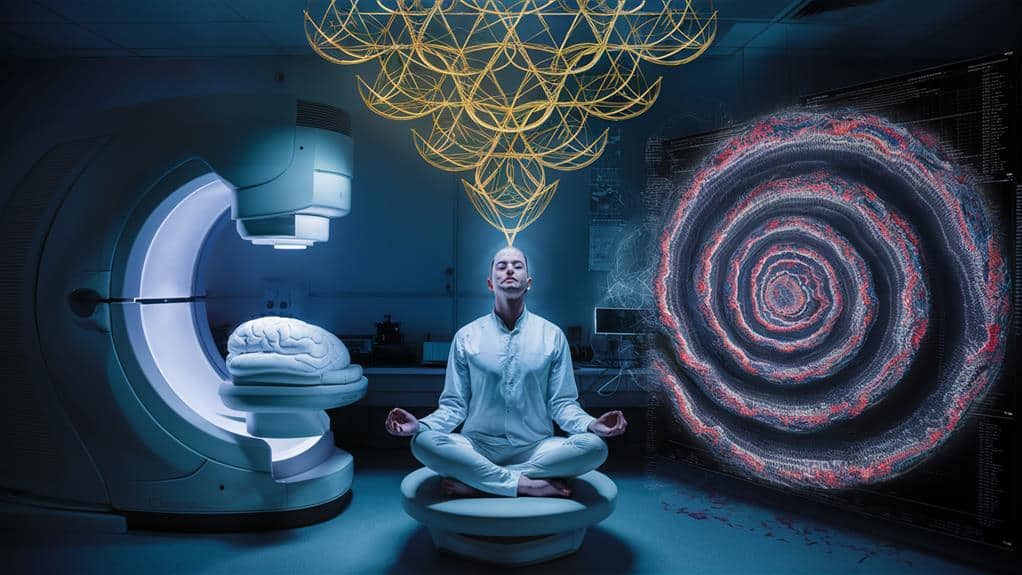The Relationship Between Mysticism and Transpersonal Psychology
You’ll find that mysticism and transpersonal psychology share an intriguing dance at the edges of human consciousness. While mysticism offers ancient pathways to transcendent experiences, transpersonal psychology provides the scientific framework to understand these profound states. Together, they’ve created a unique bridge between spiritual wisdom and psychological inquiry. As you explore their relationship, you’ll discover how figures like Jung and Maslow have woven these seemingly disparate threads into a cohesive understanding of human potential. Yet, this intersection raises compelling questions about consciousness, reality, and the nature of human experience that continue to challenge our conventional understanding.
Historical Origins and Development

The roots of mysticism and transpersonal psychology stretch back to ancient spiritual traditions that cropped up independently across various civilizations.
You’ll find these early seekers – from shamanic practitioners to Buddhist monks – exploring consciousness beyond ordinary awareness, developing methods to access transcendent states that you might recognize in today’s mindfulness practices.
As you trace this lineage forward, you’ll encounter how Western psychology began incorporating these ancestral wisdom traditions in the mid-20th century.
You’re seeing the culmination of Carl Jung‘s groundbreaking work with the collective unconscious, Abraham Maslow’s peak experiences, and Stanislav Grof’s research into non-ordinary states of consciousness.
They’ve paved the way for what you now know as transpersonal psychology.
You’re inheriting a rich tapestry where ancient mystical practices merge with modern psychological understanding.
What started as isolated spiritual quests has evolved into a systematic study of human consciousness that you can engage with through various modalities – from meditation to breathwork.
It’s a field that continues to expand your understanding of what it means to be fully human, integrating both scientific rigor and spiritual depth.
Core Concepts and Frameworks
When exploring mysticism and transpersonal psychology, you’ll encounter several fundamental principles that form its theoretical foundation. At its core, you’ll find the concept of transcendent experiences that extend beyond your ordinary sense of self, reaching into areas of consciousness that defy conventional understanding.
These experiences often dissolve the boundaries between subject and object, leading to what you might recognize as states of non-dual awareness.
You’ll discover that both mysticism and transpersonal psychology share key frameworks, including the recognition of multiple states of consciousness and the potential for profound personal transformation. Through these lenses, you’re invited to explore peak experiences, altered states, and spiritual emergencies that can reshape your understanding of reality.
The concept of ego transcendence becomes particularly significant as you’ll learn to recognize how your sense of self can expand beyond individual identity into broader domains of collective consciousness.
As you probe deeper, you’ll encounter frameworks that map the territory of human consciousness, from Maslow’s peak experiences to Grof’s holotropic states, offering you structured ways to understand these otherwise ineffable experiences.
Research Methods and Approaches

Studying mystical and transpersonal experiences requires specialized research methods that bridge objective measurement with subjective exploration. You’ll find that researchers often employ mixed-method approaches, combining quantitative scales like Hood’s Mysticism Scale with qualitative techniques such as phenomenological interviews and detailed personal narratives.
These complementary methods help capture both the measurable aspects and ineffable qualities of transcendent experiences.
When you’re examining mystical states, you’ll need to contemplate innovative research tools like neuroimaging studies that track brain activity during meditation, alongside ethnographic observations of spiritual practices across cultures.
You can’t rely solely on traditional scientific paradigms – they’re often insufficient for understanding non-ordinary states of consciousness. Instead, you’ll want to embrace participatory research methods where both researcher and subject engage in deep exploration together.
You might utilize techniques like holotropic breathwork sessions, systematic meditation studies, or carefully documented psychedelic research protocols. The key is maintaining scientific rigor while honoring the profound, deeply personal nature of mystical experiences.
Through these diverse approaches, you’re able to map the territory where measurable reality meets transcendent awareness.
Transformative Practices and Techniques
Mystics and transpersonal practitioners have developed numerous techniques to facilitate transformative experiences and altered states of consciousness. You’ll find these practices span across cultures and traditions, from ancient meditation techniques to modern breathwork protocols, each offering unique pathways to transcendent awareness and psychological integration.
When you engage in these transformative practices, you’re accessing time-tested methods that can include mindfulness meditation, holotropic breathing, sacred dance, vision quests, and contemplative prayer. Each approach serves as a gateway to expanded consciousness, helping you navigate the depths of your psyche while connecting to what many describe as the universal field of awareness.
You’ll discover that these practices aren’t merely psychological tools but rather integral components of a broader spiritual technology that’s been refined over millennia. Through consistent engagement with these methods, you’re likely to experience shifts in perception, dissolution of ego boundaries, and moments of profound clarity.
The key lies in approaching these practices with both dedication and discernment, recognizing that transformation often unfolds gradually through sustained practice rather than instantaneous breakthrough experiences.
Modern Applications and Integration

Traditional transformative practices have found new relevance in contemporary settings, from clinical psychology to corporate wellness programs. You’ll find ancient meditation techniques being adapted for stress reduction, while shamanic practices inform new approaches to trauma healing and personal growth.
These adaptations bridge the gap between timeless wisdom and modern therapeutic needs, offering you pathways to profound self-discovery within familiar frameworks.
In today’s interconnected world, you’re witnessing the integration of mystical practices with evidence-based approaches, creating powerful hybrid methodologies. You’ll discover mindfulness-based cognitive therapy incorporating Buddhist insights, while transpersonal coaching draws from both Jungian psychology and indigenous wisdom traditions.
Virtual reality technologies now facilitate immersive meditation experiences, while biofeedback devices help you track your progress in contemplative practices.
These modern applications don’t merely transpose ancient techniques into contemporary contexts – they transform them into accessible tools for your personal evolution.
You’re part of a growing movement that recognizes the value of integrating spiritual wisdom with scientific understanding, creating innovative approaches that honor both tradition and progress in the pursuit of human potential.









